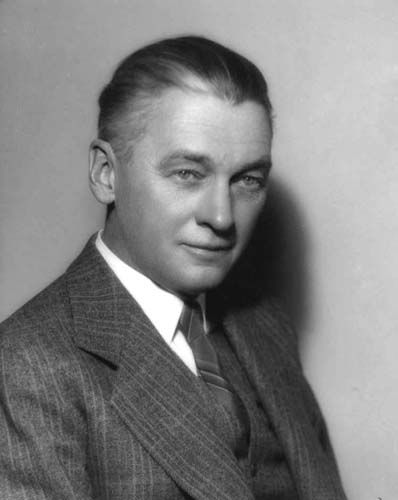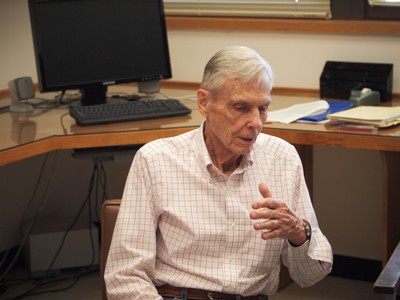<Back to Index>
- Mathematician John Torrence Tate Jr., 1925
- Painter Georges de La Tour, 1593
- Marshal of France Armand de Vignerot du Plessis, 1696
PAGE SPONSOR



John Torrence Tate Jr. (born March 13, 1925) is an American mathematician, distinguished for many fundamental contributions in algebraic number theory, arithmetic geometry and related areas in algebraic geometry.
Tate was born in Minneapolis. His father, John Tate Sr., was a professor of physics at the University of Minnesota, and a longtime editor of Physical Review. His mother, Lois Beatrice Fossler, was a high school English teacher. Tate Jr. received his bachelor's degree in mathematics from Harvard University, and entered the doctoral program in physics at Princeton University. He later transferred to the mathematics department and received his PhD in 1950 as a student of Emil Artin. Tate taught at Harvard for 36 years before joining the University of Texas in 1990. He retired from the Texas mathematics department in 2009, and currently resides in Cambridge, Massachusetts, with his wife Carol. He has three daughters with his first wife Karin Tate.
Tate's thesis (1950) on Fourier analysis in number fields has become one of the ingredients for the modern theory of automorphic forms and their L-functions, notably by its use of the adele ring, its self - duality and harmonic analysis on it; independently and a little earlier, Kenkichi Iwasawa obtained a similar theory. Together with his teacher Emil Artin Tate gave a cohomological treatment of global class field theory, using techniques of group cohomology applied to the idele class group and Galois cohomology. This treatment made more transparent some of algebraic structures in the previous approaches to class field theory which used central division algebras to compute the Brauer group of a global field.
Subsequently Tate introduced what are now known as Tate cohomology groups. In the decades following that discovery he extended the reach of Galois cohomology with the Poitou – Tate duality, the Tate – Shafarevich group, and relations with algebraic K-theory. With Jonathan Lubin, he recast local class field theory by the use of formal groups, creating the Lubin – Tate local theory of complex multiplication.
He has also made a number of individual and important contributions to p-adic theory; for example, Tate's invention of rigid analytic spaces can be said to have spawned the entire field of rigid analytic geometry. He found a p-adic analogue of Hodge theory, now called Hodge – Tate theory, which has blossomed into another central technique of modern algebraic number theory. Other innovations of his include the 'Tate curve' parametrization for certain p-adic elliptic curves and the p-divisible (Tate – Barsotti) groups.
Many of his results were not immediately published and some of them were written up by Serge Lang, Jean - Pierre Serre, Joseph H. Silverman and others. Tate and Serre collaborated on a paper on good reduction of abelian varieties. The classification of abelian varieties over finite fields was carried out by Taira Honda and Tate (the Honda – Tate theorem).
The Tate conjectures are the equivalent for étale cohomology of the Hodge conjecture. They relate to the Galois action on the l-adic cohomology of an algebraic variety, identifying a space of 'Tate cycles' (the fixed cycles for a suitably Tate - twisted action) that conjecturally picks out the algebraic cycles. A special case of the conjectures, which are open in the general case, was involved in the proof of the Mordell conjecture by Gerd Faltings.
Tate
has also had a major influence on the development of number theory
through his role as a Ph.D. advisor. His students include Joe Buhler, Benedict Gross, Robert Kottwitz, James Milne, V. Kumar Murty, Carl Pomerance, Ken Ribet, Ted Chinburg, Joseph H. Silverman, Dinesh Thakur, Jeremy Teitelbaum. In 1956 Tate was awarded the American Mathematical Society's Cole Prize for outstanding contributions to number theory. In 1995 he received the Leroy P. Steele Prize for Lifetime Achievement from the American Mathematical Society. He was awarded a Wolf Prize in Mathematics in 2002/03 for his creation of fundamental concepts in algebraic number theory. In 2010, the Norwegian Academy of Science and Letters, of which he is a member, awarded him the Abel Prize,
citing "his vast and lasting impact on the theory of numbers".
According to a release by the Abel Prize committee "Many of the major
lines of research in algebraic number theory and arithmetic geometry are
only possible because of the incisive contributions and illuminating
insights of John Tate. He has truly left a conspicuous imprint on
modern mathematics." Tate has been described as "one of the seminal mathematicians for the past half - century" by William Beckner, Chairman of the Department of Mathematics at the University of Texas.

